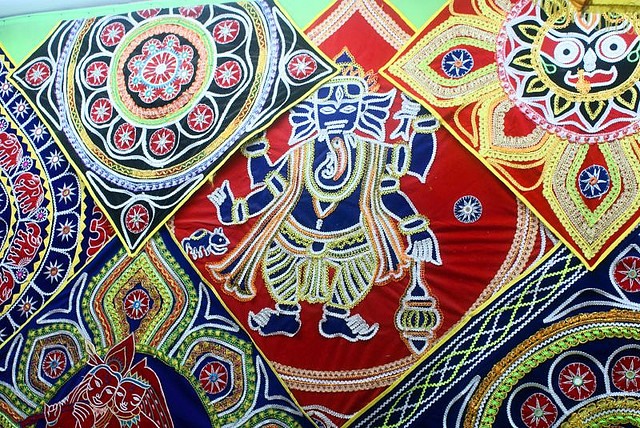'Applique', which is a French term, is a technique by which the decorative effect is obtained by superposing patches of coloured fabrics on a basic fabric, the edges of the patches being sewn in some form of stitchery. It is distinct from what is known as patch work in which small pieces of cut fabrics are usually joined side by side to make a large piece of fabric or for repairing a damaged fabric. Though the form is not unknown in other parts of India, it is Orissa and specially in Pipli that the craft has a living and active tradition continuing over centuries. While the largest number of applique craftsmen are concentrated in Pipli, there are quite a few in Puri and very small numbers in Khallikote, Parlakhemundi and Boudh areas also.
Like patachitras, appliqué work in Orissa also originated as a temple art. The artisans of Pipli - a village 40 km from Puri have their mastery in applique art. Besides Puri, appliqué work is also practiced in Chitki, Barpali, and a couple of other places.
Colored cloth, are stitched in shape of animals, birds, flowers and beautiful wall, garden or beach umbrella, a lamp shade and much more hangings are made.
Saris and other attires are designed with appliqué work, which is gaining lot of popularity in international market. Tiny mirrors are stick or stitched by thread embroidery to create a remarkable work of art. Colors like red, yellow, white and black are mainly used, in applique work whereas green has also been added in recent times.
The stitching process varies from item to item and come under six broad categories, namely, (1) bakhia, (2) taropa, (3) ganthi, (4) chikana, (5) button-hole and (6) ruching. Sometimes emroidered patterns are also used and in a few items mirror work is also incorporated. The layout of various motifs and patterns vary according to the shape of the piece. The canopy has a large centre piece which may be a square. This centre piece is then bounded by several borders of different widths, one outside the other, till the edge is reached. In the umbrella and Chhati the inner field is arranged in circles, each circle having patches of one motif placed side by side. Patterns are laid in the same way as the shape of the Tarasa, with a large motif or two placed at the centre. The layout for covers for horses consists of a series of concentric strips in the portion which covers the neck, each strip having patches of one motif, while the portions which fall on either side of the body are plain, having border all round with or without a motif at the centre of the plain field.

